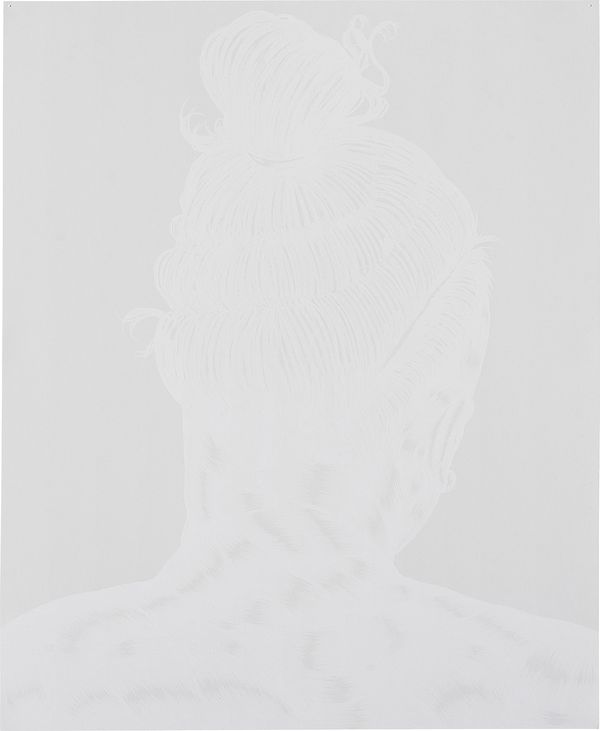Toyin Ojih Odutola They, 2015
In They, executed in 2015, Toyin Ojih Odutola expands her progressive examination of the human form by toying with tonal variations and subtle delineation in her pared-back palette. Exquisitely executed in white charcoal on paper, the sitter’s back and hair emerges from the white ground as the viewer moves around the work. With the onlooker’s moving perspective, the light and dark areas shift and alter, unveiling the contours of the central figure. The work beautifully exemplifies the artist’s distinct exploration of skin and hair and showcases her mastery of mark-marking. Imbuing her unnamed subjects with an energetic vitality, the forms of her unknown sitters are layered through a stratum of charcoal strokes, showcasing her blocks of shading and adept use of materials. Included in Ojih Odutola’s solo exhibition Of Context and Without at Jack Shainman Gallery in 2015 to 2016, the artist’s work has been celebrated internationally and most notably at her first solo museum exhibition, To Wander Determined, at the Whitney Museum of American Art in 2017.
Toyin Ojih Odutola They, 2015
Executed in a monochrome palette, the present work exposes the artifice of the artwork, unveiling Ojih Odutola’s painstaking application of line. "I want the marks to be the subject … In particular, I’m exposing my process but I am doing this because I want people to see what I see in the makings of these works that often doesn’t get shown in the final product. It’s like I’m welcoming them into my studio for a moment with each drawing" (the artist, quoted in Michael Slenske, ‘Toyin Ojih Odutola explores race and identity in black and white’, Wallpaper, 8 December 2015, online). Exploring gentle tonality, Ojih Odutola’s work from this period also omits color, exposing the vast array of tones generated from black to white. Unlike other African American artists, such as Kerry James Marshall and Barkley Hendricks who provided inspiration to the young artist, Ojih Odutola’s unique omission of color in this series removes color associations, leaving the viewer with a more subjective reading of her work. "I wanted to see what I could do if I minimized all of that and have the outcome be just as interesting if not more interesting when the connotations associated with a broader color palette were omitted" (the artist, quoted in E. Lopiccolo, ‘Toyin Ojih Odutola’s “Of Context and Without” at Jack Shainman’, Whitewall, 26 January 2016, online). This monochromatic palette evident in her 2015 works served as a tool for the removal of recognizable motifs and clues which viewers automatically rely on to read an image.
What I really loved is that when you use black as a demarcating tool and replace it with white it suddenly makes things really, really slippery and people get uncomfortable because they can’t delineate anything… All of a sudden this idea of context is very suspect and the content becomes unreliable. – Toyin Ojih Odutola
The use of charcoal in They offers differing qualities to pen and ink, namely a matte finish and slower more methodical rhythm, as a result of the brittle and frictious nature of the material; the charcoal layer appears gentle yet supple like the skin and hair the artist so uniquely depicts. The familiar smooth texture of humans’ unifying physical outer layer is transformed into thousands of tiny lines or strokes, from which the resulting effects range from the appearance of coils of wire to braided glistening threads. The artist has explained that the origin of this, stemmed from an intention to investigate what skin felt like and how it creates parameters for movement and possibility. "The style I employ was my way of questioning that surface and seeing the ways I could expand on it" (the artist, quoted in K. Farr, ‘Beyond the Cover: Toyin Ojih Odutola’, Juxtapoz, 28 September 2017, online). The tightly woven strands which form the surface of each of the artist’s portraits can be seen as form of repetitive pattern which runs through Ojih Odutola’s oeuvre. The artist has likened pattern as a form of readable language, relating it to her experiences arriving in the United States from Nigeria as a child and being unable to understand English. The conscious removal of visual signposting in works such as They can be associated with the artist’s preoccupation with nonverbal communication and expression. Both unifying and alienating, this approach represents, in part, the artist’s conveyance of migration and assimilation as themes in her work.
As in the present work, which portrays the intimate nape of an unknown figure’s neck, Ojih Odutola’s first solo museum exhibition in New York at the Whitney Museum of American Art included a series of portraits depicting two fictional aristocratic Nigerian families. These life-size figures were situated in the context of domesticity and leisure, constructed through visual signifiers from art history to popular culture. In the same way that these imaginary characters rely on the viewer to construct their narrative, They's complete absence of context signals the artist’s approach to her work through a formalist lens, moving away from traditional portraiture which heralded its lauded named sitters, as evident in the work of her cited influence, John Singer Sargent. Ojih Odutola has said of this "The application mirrors how an image can be understood. And since everyone has their own distinctive framework of reference, the reads involved with my drawings range from scarification, to hair and muscle, to the internal, intangible workings of a person, to the political implications of race and class, and so forth. I don’t discount any of that. I actually welcome it; but when I initially set down a composition or sketch out an idea, I am not thinking about those things at all" (the artist, quoted in K. Farr, ‘Beyond the Cover: Toyin Ojih Odutola’, Juxtapoz, 28 September 2017, online).

